In the tapestry of Canadian identity, few symbols resonate as deeply as maple syrup. Whether it’s drizzled over a stack of pancakes, made into maple candy or exchanged as a gift, this delicacy embodies Canada.
As the 2024 maple syrup season comes to a close, it is difficult to overlook the notable challenges confronting Canada’s agricultural sector, particularly with high grocery costs, labour shortages and the escalating impacts of climate change splashed across daily newspapers.
While government investments tend to chase new and emerging fields, it often seems that bedrock sectors of our economy are forgotten. Agriculture and agri-food, for example, is driven by relentless research, technological advances and adaptability. The sector contributed $143.8 billion to Canada’s GDP in 2022 alone.
Reflecting that ingenuity, partnerships between the agricultural sector and Canada’s polytechnics abound.
Institutions serve as catalysts for industry innovation activity, facilitating research that yields tangible solutions to real-world challenges. Private sector partners also retain the intellectual property associated with this research, enabling them to maximize the potential to commercialize new products and propel growth.
For example, Cascade’s innovative irrigation wheel, developed in collaboration with RRC Polytech, demonstrates an alliance that enabled the rapid translation of research findings into a marketable product. It also contributes a solution to one of the agricultural sector’s biggest challenges: ensuring crops are sustainable even as weather patterns change.
Meanwhile, Kwantlen Polytechnic University researchers working with Aeroroot Systems have perfected a soil-free method for cultivating basil using aeroponics. This innovation not only showcases the potential of technology to enhance agricultural practices but also highlights how institutions support both commercialization and sustainability.
At George Brown College’s Food Innovation and Research Studio, researchers help food and beverage companies enhance product quality and overcome manufacturing obstacles. A recent project with the Healthy Crunch Company offers one such example, with a packaging innovation that helped extend their product’s shelf-life.
These examples underscore how industry-relevant research and innovation can unlock the full potential of a sector critical to Canada’s economy. Yet, industry partnerships aren’t confined to the research lab.
Labour shortages in this sector are also acute. In 2022, 35 per cent of the agricultural workforce was over the age of 55, with more than 30 per cent expected to retire by 2030. The same institutions that grapple with innovation challenges make important contributions here as well, offering programs that equip new learners and experienced workers with the skills needed to revolutionize farming practices, foster innovation and optimize food processing.
For example, Saskatchewan Polytechnic plays a pivotal role training the next generation of agricultural professionals. An agriculture technology bootcamp ties into their broader programming, providing hands-on learning opportunities and ensuring a steady supply of skilled workers to meet the sector’s needs.
Even innovative players in longstanding economic sectors need help from time to time. Canada’s polytechnics stand ready to assist.

